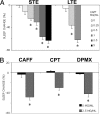Drosophila D1 dopamine receptor mediates caffeine-induced arousal
- PMID: 19074291
- PMCID: PMC2629270
- DOI: 10.1073/pnas.0806776105
Drosophila D1 dopamine receptor mediates caffeine-induced arousal
Abstract
The arousing and motor-activating effects of psychostimulants are mediated by multiple systems. In Drosophila, dopaminergic transmission is involved in mediating the arousing effects of methamphetamine, although the neuronal mechanisms of caffeine (CAFF)-induced wakefulness remain unexplored. Here, we show that in Drosophila, as in mammals, the wake-promoting effect of CAFF involves both the adenosinergic and dopaminergic systems. By measuring behavioral responses in mutant and transgenic flies exposed to different drug-feeding regimens, we show that CAFF-induced wakefulness requires the Drosophila D1 dopamine receptor (dDA1) in the mushroom bodies. In WT flies, CAFF exposure leads to downregulation of dDA1 expression, whereas the transgenic overexpression of dDA1 leads to CAFF resistance. The wake-promoting effects of methamphetamine require a functional dopamine transporter as well as the dDA1, and they engage brain areas in addition to the mushroom bodies.
Conflict of interest statement
The authors declare no conflict of interest.
Figures





References
-
- Porkka-Heiskanen T, Alanko L, Kalinchuk A, Stenberg D. Adenosine and sleep. Sleep Med Rev. 2002;6:321–332. - PubMed
-
- Quarta D, et al. Adenosine receptor-mediated modulation of dopamine release in the nucleus accumbens depends on glutamate neurotransmission and N-methyl-D-aspartate receptor stimulation. J Neurochem. 2004;91:873–880. - PubMed
-
- Ferre S. An update on the mechanisms of the psychostimulant effects of caffeine. J Neurochem. 2008;105:1067–1079. - PubMed
-
- Basheer R, Strecker RE, Thakkar MM, McCarley RW. Adenosine and sleep-wake regulation. Prog Neurobiol. 2004;73:379–396. - PubMed
Publication types
MeSH terms
Substances
LinkOut - more resources
Full Text Sources
Medical
Molecular Biology Databases

